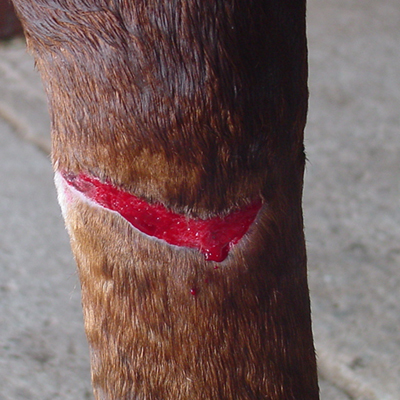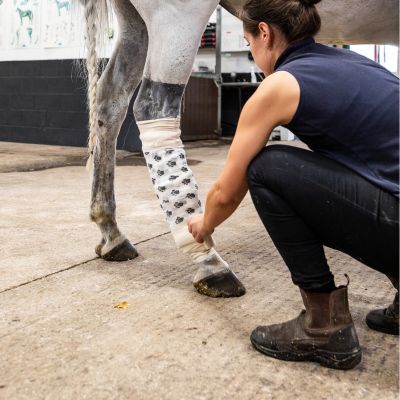Wounds
Wounds are very common injuries in horses and it is vital for you as a horse owner to be able to evaluate the severity of a cut. If you are in any doubt as to the significance of a wound it is best to contact your us for advice.
WOUNDS
Wounds are very common injuries in equines and it is vital for the horse owner to be able to evaluate the severity of a cut. Some wounds can be managed without veterinary assistance but many will require professional attention. It may be possible to provide important first aid before the vet arrives.
Innocuous-looking wounds can be the most dangerous, so if you are in any doubt as to the significance of a wound it is best to contact your vet for advice.

FIRST AID TREATMENT
- First of all, keep calm and ensure personnel safety at all times.
- Adequately restrain and move your horse to a safe area to prevent further injury.
- Briefly assess the injury and check if the horse is lame. Bigger dramatic wounds aren’t necessarily more serious – small puncture wounds can penetrate deep tissues.
- Decide if the wound requires veterinary attention (e.g. for severe bleeding, suturing, puncture wounds, lameness, etc.). Call us on 01772 861300 and relay your findings – this will allow us to be better prepared and give you some advice until we can get there.
- Clean the wound gently. Gross contamination (such as with mud) can be hosed with water on a low pressure. Dirty wounds can be cleaned with a very dilute antiseptic solution. Small clean wounds can be flushed with sterile saline. Trim any long hair from around the wound.
- Check if the wound is over a joint or tendon sheath. Puncture wounds into these structures can be disastrous if not treated within 24-48 hours, so if in any doubt call us. Clear fluid trickling from a wound over a joint could be joint fluid.
- Apply a sterile non-adherent dressing to the wound. Follow with cotton wool or gamgee, then elastic bandage. Always ensure there is sufficient padding and that a finger can easily be inserted under the bandage. Sticky pads are available to cover wounds on areas which can’t be bandaged.
- Always have a plan for transport and insurance papers handy.
WHAT TO DO IF…
The wound is spurting blood/bleeding heavily
Aim to quickly stop the flow. Use hand pressure if this is all you have available. Ideally a clean sterile pressure bandage should be applied.
In the case of an emergency use a piece of gamgee and then a tight ‘Vetrap’. This can be safely left in place for up to 2 hours until veterinary attention is sought. tail or exercise bandages can be used, but always put padding underneath them.
If blood seeps through the bandage, apply more layers very firmly. Even arterial bleeding can usually be stemmed like this. For wounds in areas that can’t be bandaged, maintain firm hand pressure over the wound using clean padding.
The wound is bleeding
The initial treatment should comprise of gently cleaning using gentle hosing or bathing with clean cotton wool or swabs in a very dilute saline solution. A tea spoon of salt to 1 litre of water. Using iodine/hibiscrub solutions can damage the tissues if not sufficiently diluted and be very cautious about any product around the eyes.
The horse is very lame
If the horse will not place any weight on the limb at all, leave it where it is in case there is a fracture underneath the wound. If the horse is able to walk, very slowly move it to a clean yard or stable if possible. Your vet should always be called if the horse is obviously lame and has a wound in case a joint or tendon sheath infection is present.
There is something in the wound
Obvious blood, soil and other debris should be removed from around the wound. Once cleaned a sterile dressing can then be applied until the veterinary examination can take place.
If a foreign body is visible in the wound, leave it in place if at all possible and call the vet to attend. This may help your vet to evaluate the damage and it may be dangerous, to yourself and the horse, to remove it.

BANDAGING A WOUND
In an emergency, it doesn’t matter what the bandage looks like but an overtight bandage may cause damage, especially if left on for over 2 hours. You must ensure:- The injured area is protected
- The bandage fits snugly and is well padded
- There is even pressure over tendons
- There is no pressure over bony prominences e.g. at the back of the knee
- Soft tissues in the opposite limb are supported
